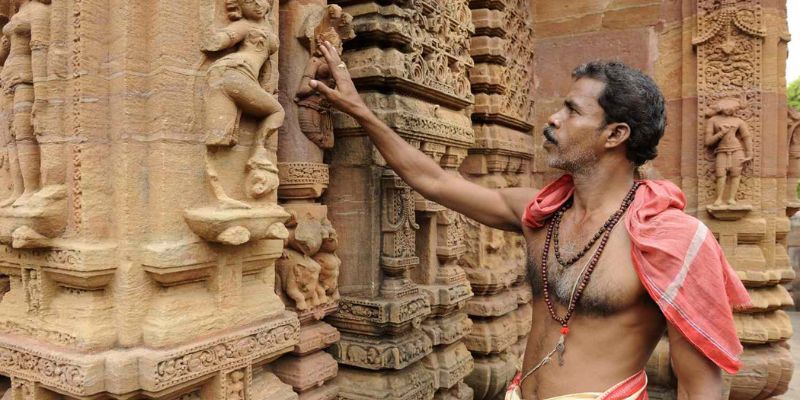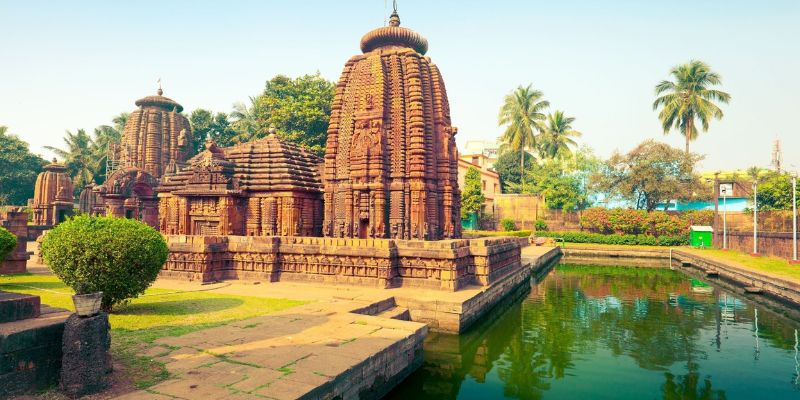Bhubaneswar, also known as the Temple City of India, is a popular tourist destination due to its astonishingly beautiful temples. The architecture and craftsmanship that went into shaping these monumental sites are remarkable and will leave you in awe with their distinct features.
Bhubaneswar's ancient history dates back centuries when it was an important centre for commerce and religious study in the region. With so many incredible temple complexes located here, we've compiled a list of some of the most significant ones you must visit, if ever in the city.
Discover intricate carvings from bygone eras, and learn about fascinating myths associated with them while admiring breathtaking sights across each one – stay tuned to find out what they are.
Lingaraj Temple
Lingaraj Temple is arguably the most significant temple in Bhubaneswar and has been designated as a UNESCO World Heritage Site. Dedicated to Lord Shiva, it is one of India's most revered Hindu shrines and stands tall amidst its surrounding complex of 150 other temples.
The Lingaraj Temple is believed to be 1000 years old and is characterised by its unique architecture and sculptured stone images depicting an era of great craftsmanship. The 40-meter-high tower of the temple is a sight to behold, made entirely out of sandstone with intricate carvings on its surface.
Notable attractions include the five inside shrines dedicated to Lord Shiva's consorts – Parvati, Annapurna, Ganga, Yamuna, and Saraswati. Visitors can also find two huge ponds located nearby – the Surya Kund and the Bindu Sagar – which are said to be sacred sites that cure illness. Furthermore, a temple dedicated to Lord Hari (Vishnu) is opposite the main Lingaraj Temple. The entire complex here is an absolute marvel and will leave you captivated.
Mukteshwar Temple
Mukteshwar Temple is an exquisite 10th-century temple located in Bhubaneswar. Dedicated to Lord Shiva, the temple is widely revered for its intricate architecture and craftsmanship, dating back to the 7th century.
The temple is known for its iconic 'Torana,' or arched gateway, added in the 10th century and said to symbolise victory and liberation. Visitors can admire beautiful carvings on the walls depicting scenes from Hindu mythology, such as Ravana shaking Mount Kailash and Shiva dancing at his wedding.
The temple also has a unique sculpture of Lord Shiva in his 'Muktheshwar' form, believed to have been built in the 2nd century CE. Furthermore, visitors can find an open-air theatre located nearby which is said to be the oldest surviving one in India. With so much to explore and learn here, Mukteshwar Temple is a must-see destination in Bhubaneswar.
Rajarani Temple

Rajarani Temple, also known as the 'Love Temple,' is a captivating 11th-century temple in Bhubaneswar. It is dedicated to Lord Shiva and stands out for its distinct architecture, which consists of Sapta-Matrikas (seven mother goddesses) adorning the exterior walls.
Inside, visitors can find an awe-inspiring sculpture of Lord Shiva in his 'Anantasayana' form, which is said to represent the god in dreamland. The temple also houses several other sculptures depicting scenes from Hindu mythology, such as Arjuna and Lord Krishna's cosmic dance, which visitors admire for their craftsmanship.
Rajarani Temple is known for its various erotic carvings, depicting a variety of intimate poses between couples. Scholars believe these sculptures were created to celebrate the sacred art of love and signify desire, joy, and pleasure. Whether you're here for its spiritual significance or to admire its architecture, Rajarani Temple is an absolute must-visit destination in Bhubaneswar!
Ananta Vasudeva Temple
Ananta Vasudeva Temple is a majestic 11th-century temple in Bhubaneswar dedicated to Lord Vishnu. The temple stands out for its impressive architecture and craftsmanship, with intricate carvings depicting scenes from Hindu mythology.
Notable attractions here include the Jagamohan (entrance hall), which has several sculptures of Lord Vishnu in various forms. Inside, visitors can find a beautiful sculpture of Lord Vishnu sleeping on the serpent Adi Shesha, with Goddess Laxmi massaging his feet – considered one of the most iconic and powerful images of the Hindu God Vishnu.
The temple also has two distinct shrines dedicated to Goddess Laxmi and Sridevi (consort of Vishnu). Ananta Vasudeva Temple is a spiritual and breathtaking place to visit, with its intricate carvings that will leave you in awe of its beauty.
Parasurameswara Temple
Parasurameswara Temple is a stunning 8th-century temple located in Bhubaneswar. Dedicated to Lord Shiva, the temple stands out for its distinct architecture and sculptures depicting various Hindu gods and goddesses.
Notable attractions include a beautiful sculpture of Lord Shiva in his 'Parasuram' form – which is believed to be installed by Parasurama, an incarnation of Vishnu. Visitors can find several other sculptures depicting scenes from Hindu mythology, such as Lord Shiva and Goddess Parvati's cosmic dance.
The temple also houses a beautiful shrine dedicated to Goddess Bhudevi – the consort of Vishnu. With its unique sculptures and architecture, Parasurameswara Temple is certainly an unmissable destination in Bhubaneswar.
Brahmeshwar Temple
Brahmeshwar Temple is a magnificent 10th-century temple in Bhubaneswar. Dedicated to Lord Shiva, it is one of the few temples here that resides on top of a hill – offering visitors panoramic views of the surrounding cityscape.
The temple stands out for its distinct architecture and sculptures depicting various Hindu gods and goddesses. Notable attractions include a beautiful sculpture of Lord Shiva in his 'Brahmeshwar' form, believed to have been installed by Brahma himself.
Visitors can find several other sculptures depicting scenes from Hindu mythology, such as the cosmic dance between Lord Shiva and Goddess Parvati. Furthermore, the temple also houses two smaller shrines – one dedicated to Lord Ganesha and the other to Goddess Durga.
Ram Mandir

Ram Mandir is a revered 12th-century temple located in Bhubaneswar. The temple is dedicated to Lord Rama and is widely revered as one of the holiest sites in the city, with pilgrims from near and far coming to pay their respects.
Notable attractions include:
- It's an iconic tower entrance.
- Intricate carvings of Lord Rama and other Hindu gods.
- A beautiful sculpture of Lord Shiva in his 'Parasuram' form inside the temple.
Visitors can find several sculptures depicting scenes from the Ramayana, such as Sita's abduction by Ravana or Hanuman bearing the life-saving herb for Rama's brother Lakshmana. With its beautiful architecture and spiritual significance, Ram Mandir is a must-visit destination in Bhubaneswar.
FAQs
Which is the most famous temple in Bhubaneswar?
The most famous temple in Bhubaneswar is the Mukteshwar Temple, known for its iconic arched gateway and unique sculpture of Lord Shiva. It has a rich spiritual history and is one of the must-see destinations in Bhubaneswar.
What are some other popular temples in Bhubaneswar?
Other popular temples in Bhubaneswar include Rajarani, Ananta Vasudeva, Parasurameswara, Brahmeshwar, and Ram Mandir. Each of these temples is unique – be it for its awe-inspiring architecture, intricate sculptures, or spiritual significance.
What is Bhubaneswar temple famous for?
Bhubaneswar is famous for its temples – with some of the most iconic and revered temples in India located here. The city has been a major pilgrimage centre since ancient times and continues to be so, thanks to its many majestic temples.
Conclusion
In conclusion, the temples of Bhubaneswar are a testament to Orissa's rich cultural and religious history. Each is steeped in spiritual significance, from the Lingaraj Temple to the Ram Mandir. These unique sites still stand as reminders of how the people of Orissa have long held their faith close to their hearts. Visiting any of these magical temples allows us to experience some of this culture and develop our appreciation for these amazing landmarks. We all should take an opportunity to pay homage to such treasured places and learn more about them than what can be found through books or articles alone.




